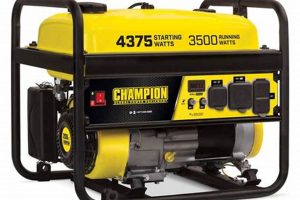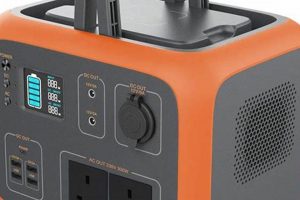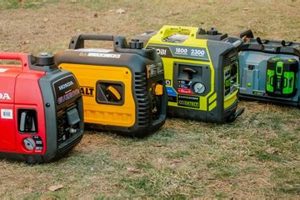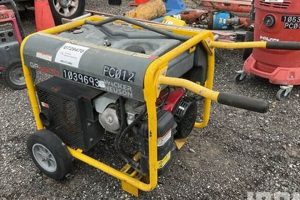A decibel (dB) measurement quantifies the sound pressure level produced by a device. For portable generators, this measurement indicates how loud the generator will be during operation. A lower dB rating signifies a quieter operation, for example, a generator rated at 60 dB is quieter than one rated at 70 dB. The sound level is typically measured at a fixed distance, often seven meters.
Understanding sound output is crucial for user comfort and environmental impact. Excessive noise can disrupt conversations, disturb neighbors, and even violate local noise ordinances. Choosing a generator with a low decibel rating ensures quieter operation, minimizing disturbances and promoting a more peaceful environment. The increasing demand for quieter generators has driven manufacturers to innovate and develop technologies that reduce operational noise. Historically, portable generators were notoriously loud, but advancements in muffler technology and engine design have led to significant improvements.
This article will further explore the factors influencing sound levels, discuss various decibel ratings and their real-world implications, and provide guidance for selecting a generator with an appropriate sound output for specific needs. It will also delve into methods for further reducing noise during operation.
Tips for Selecting a Generator Based on Sound Output
Careful consideration of sound output is essential when choosing a portable generator. These tips provide guidance for assessing and minimizing noise pollution.
Tip 1: Lower dB ratings equate to quieter operation. A difference of even 10 dB represents a significant change in perceived loudness. Aim for the lowest dB rating possible within budget and power requirements.
Tip 2: Consider the operating environment. In noise-sensitive environments like campsites or residential areas, prioritize generators with lower dB ratings. Conversely, in construction sites or industrial settings, higher dB ratings may be acceptable.
Tip 3: Research specific models. Manufacturer specifications often include dB ratings. Consult reviews and comparisons to gauge real-world sound levels.
Tip 4: Factor in load. Sound levels can fluctuate depending on the load placed on the generator. Consider the anticipated power demands and how they might affect noise output.
Tip 5: Explore sound-dampening accessories. Sound-reducing enclosures or baffles can further minimize noise pollution. These accessories can be purchased separately and are particularly useful in noise-sensitive areas.
Tip 6: Maintain proper distance. Positioning the generator farther away from living or working spaces reduces the impact of noise. Utilize extension cords safely to achieve optimal distance.
Tip 7: Adhere to local regulations. Research local noise ordinances before operating a generator. Some areas have restrictions on permissible sound levels, particularly during specific hours.
By following these tips, individuals and organizations can select and operate portable generators responsibly, minimizing noise pollution and promoting a more peaceful environment.
Ultimately, selecting a generator requires balancing power needs with noise considerations. This article will now offer concluding remarks on the importance of responsible generator use.
1. Noise Levels
Noise levels represent a critical factor in portable generator selection and operation. Understanding the relationship between decibel (dB) ratings and perceived loudness is essential for minimizing noise pollution and ensuring responsible generator use. This section explores the multifaceted implications of noise levels concerning portable generators.
- Perceived Loudness
Decibel ratings correlate directly with perceived loudness. A 10 dB increase represents a doubling in perceived loudness. A 60 dB generator is perceived as significantly quieter than a 70 dB unit, and a 50 dB generator is even quieter still. This logarithmic scale highlights the importance of even small differences in dB ratings.
- Environmental Impact
Excessive noise from generators can disrupt natural soundscapes, impacting wildlife and contributing to overall noise pollution. Choosing a quieter generator, indicated by a lower dB rating, minimizes this environmental impact. In noise-sensitive areas, such as national parks or residential neighborhoods, a lower dB rating becomes particularly important.
- Regulatory Compliance
Many jurisdictions have noise ordinances that restrict permissible sound levels, particularly during certain hours. Generator dB ratings assist users in complying with these regulations. Ignoring these rules can lead to fines or other penalties. Researching local noise ordinances before operating a generator is crucial.
- Operational Comfort
Operating a loud generator can be disruptive and uncomfortable for users and those nearby. Lower dB ratings contribute to a more pleasant operational experience, allowing for conversation and reducing stress. For extended operation, a quieter generator is significantly more comfortable.
By carefully considering these facets of noise levels, users can select and operate portable generators responsibly, minimizing their impact on the surrounding environment and promoting a more harmonious coexistence between power needs and noise considerations. Ultimately, prioritizing lower dB ratings benefits both the user and the surrounding community.
2. Environmental Impact
Portable generators, while offering essential power in various situations, contribute to noise pollution. The environmental impact of this noise pollution, directly linked to a generator’s decibel (dB) rating, warrants careful consideration. Higher dB ratings correlate with greater noise pollution, impacting wildlife, ecosystems, and overall environmental health.
Noise pollution from generators can disrupt wildlife communication, breeding patterns, and predator-prey relationships. For instance, studies have shown that chronic noise exposure can negatively impact bird populations, forcing them to abandon habitats or altering their vocalizations. In sensitive ecosystems, even seemingly moderate noise levels can have cascading effects on the delicate balance of nature. Furthermore, prolonged exposure to noise can negatively impact human health, causing stress, sleep disturbances, and cardiovascular issues. These impacts underscore the importance of selecting generators with lower dB ratings.
Mitigation strategies, including choosing generators with lower dB ratings and employing noise reduction techniques, are crucial for responsible generator use. Utilizing sound-dampening enclosures or strategically positioning generators away from noise-sensitive areas can significantly reduce environmental impact. Ultimately, understanding the link between dB ratings and environmental impact fosters more responsible generator selection and operation, minimizing disruption to the surrounding environment and promoting sustainable practices. Prioritizing lower dB ratings demonstrates a commitment to environmental stewardship while still meeting power needs.
3. Regulations Compliance
Regulations regarding noise pollution exist to protect public health and well-being. Portable generator operation often falls under these regulations, making compliance essential for responsible use. Decibel (dB) ratings provide a quantifiable measure of a generator’s sound output, directly relating to compliance with established noise limits.
- Local Ordinances
Municipalities frequently implement noise ordinances that restrict permissible sound levels, often varying by time of day and zoning designation. These ordinances typically specify dB limits at property lines. Exceeding these limits can result in fines or legal action. Consulting local ordinances before operating a portable generator is crucial for ensuring compliance.
- Construction Site Regulations
Construction sites, while often subject to less stringent noise regulations than residential areas, still have limitations. Regulations may specify permissible dB levels during certain hours or require noise mitigation measures for equipment like generators. Understanding these specific regulations ensures compliance and avoids potential penalties.
- Campground and Recreational Area Rules
Campgrounds and recreational areas frequently impose noise restrictions to maintain a peaceful environment. These rules often include specific quiet hours and dB limitations for generators. Adhering to these rules ensures a positive experience for all visitors and protects the natural soundscape.
- Occupational Safety and Health Administration (OSHA) Standards
In occupational settings, OSHA sets standards to protect worker hearing. While not directly related to environmental noise, OSHA regulations emphasize minimizing noise exposure in the workplace, which can influence generator selection and operation. Employers must provide hearing protection when noise levels exceed permissible limits.
Compliance with noise regulations demonstrates responsible generator use. Selecting generators with lower dB ratings simplifies compliance, minimizes disturbances, and fosters a positive relationship between power needs and community well-being. Ultimately, responsible generator operation requires a comprehensive understanding and adherence to applicable regulations, contributing to a quieter and more considerate environment.
4. Operational Comfort
Operational comfort significantly influences the overall experience of using a portable generator. Noise levels, directly correlated with decibel (dB) ratings, play a crucial role in determining this comfort level. Lower dB ratings generally translate to quieter operation and increased user comfort. This section explores the multifaceted aspects of operational comfort related to generator noise.
- Stress Reduction
Prolonged exposure to loud noise, common with higher dB-rated generators, can induce stress and fatigue. Quieter generators, with lower dB ratings, minimize this stress, promoting a more relaxed and comfortable experience, especially during extended operation.
- Conversation and Communication
High noise levels from generators can impede conversation and communication in the vicinity. Lower dB ratings facilitate easier communication, crucial in settings like campsites or during power outages where clear communication is essential.
- Sleep Disruption
Operating a loud generator near sleeping areas can severely disrupt sleep patterns. Lower dB ratings minimize sleep disturbance, particularly important for nighttime operation or in residential settings. This is especially critical for individuals sensitive to noise.
- Hearing Protection
While hearing protection can mitigate noise exposure, continuous use can be inconvenient and uncomfortable. Generators with lower dB ratings often reduce the need for hearing protection, improving overall comfort and convenience during operation.
Prioritizing operational comfort requires careful consideration of dB ratings when selecting a portable generator. Lower dB ratings contribute significantly to a more positive user experience, reducing stress, facilitating communication, and minimizing sleep disruption. Ultimately, choosing a quieter generator enhances usability and overall satisfaction.
5. Neighborly Consideration
Operating a portable generator necessitates considering its impact on neighbors. Noise levels, directly related to a generator’s decibel (dB) rating, play a critical role in maintaining positive neighborly relations. Higher dB ratings often lead to increased noise pollution, potentially causing disturbances and friction within a community. Demonstrating neighborly consideration involves selecting and operating generators responsibly, minimizing noise intrusion and promoting a harmonious living environment.
- Noise Disturbance
Loud generators can disrupt daily activities, such as conversations, relaxation, and sleep. Noise intrusion can strain neighborly relations, leading to complaints and disputes. Selecting a generator with a lower dB rating demonstrates consideration for neighbors’ peace and quiet.
- Time of Operation
Even quieter generators can cause disturbance if operated during inappropriate hours. Limiting operation during nighttime hours or adhering to community quiet times demonstrates respect for neighbors’ schedules and reduces potential disruptions. Communicating planned generator use with neighbors can further mitigate potential issues.
- Generator Placement
Strategic placement of a generator can significantly impact noise levels experienced by neighbors. Positioning the generator farther from property lines and directing exhaust away from neighboring residences minimizes noise intrusion and demonstrates consideration for their living environment.
- Communication and Transparency
Open communication with neighbors regarding generator use can foster understanding and prevent misunderstandings. Informing neighbors about the necessity of generator use and planned operating schedules promotes transparency and builds positive community relations. Addressing any concerns proactively demonstrates respect and consideration.
Prioritizing neighborly consideration requires selecting generators with lower dB ratings and operating them responsibly. Minimizing noise disturbance through thoughtful operation and open communication fosters positive community relationships and contributes to a more peaceful and respectful living environment. Ultimately, responsible generator use reflects a commitment to both individual needs and the well-being of the surrounding community.
Frequently Asked Questions about Generator Sound Levels
This section addresses common inquiries regarding decibel ratings and their implications for portable generator selection and operation.
Question 1: How are decibel (dB) ratings for portable generators measured?
Measurements are typically taken at a fixed distance, often seven meters, from the operating generator. The specific measurement procedures may vary slightly between manufacturers, but the goal remains consistent: to provide a standardized measure of sound output.
Question 2: What constitutes a “low” dB rating for a portable generator?
Generally, ratings below 60 dB are considered relatively quiet. However, the perception of “low” depends on the specific environment and individual sensitivities. Generators rated 50 dB or lower are exceptionally quiet, while those above 70 dB are generally considered loud.
Question 3: Do inverter generators typically have lower dB ratings than conventional generators?
Inverter generators are generally quieter than conventional generators due to their variable engine speed and advanced muffler designs. They often operate at lower speeds, producing less noise, especially at lower loads.
Question 4: How does the load on a generator affect its sound output?
Increased load generally leads to higher engine speed and consequently, increased noise. The dB rating provided by the manufacturer usually reflects the sound level at a specified load. Understanding how sound output varies with load helps in selecting an appropriately sized generator.
Question 5: Can sound-dampening enclosures or other accessories effectively reduce generator noise?
Sound-dampening enclosures, baffles, and other accessories can significantly reduce noise. These purpose-built solutions absorb and deflect sound waves, lowering the overall dB level experienced by those nearby.
Question 6: What resources are available for determining local noise ordinances?
Local government websites, municipal offices, or environmental agencies can provide information on noise ordinances. These resources outline permissible sound levels and any specific restrictions regarding generator operation.
Understanding dB ratings empowers informed decisions regarding portable generator selection and operation. Careful consideration of these factors ensures compliance with regulations, minimizes noise pollution, and promotes a more peaceful environment for all.
For further information on selecting the right portable generator for specific needs, please consult the subsequent sections of this article.
Decibel Ratings
Careful consideration of decibel ratings is paramount when selecting a portable generator. This article has explored the multifaceted implications of sound output, emphasizing the relationship between decibel levels and environmental impact, regulatory compliance, operational comfort, and neighborly consideration. Understanding these factors empowers informed decision-making, enabling consumers and professionals to choose generators that balance power needs with noise responsibility.
Ultimately, responsible generator use requires a commitment to minimizing noise pollution. Prioritizing lower decibel ratings contributes significantly to a quieter and more considerate environment. The ongoing development of quieter generator technologies offers promising advancements in noise reduction, paving the way for a future where power generation coexists harmoniously with community well-being.






